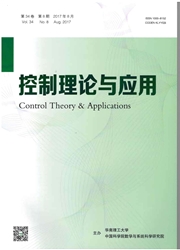

 中文摘要:
中文摘要:
炼钢–精炼–连铸是钢铁产品的关键生产工序,其有效的调度对生产过程中减少热能消耗、提高生产效率具有重要意义.根据生产过程中工序加工时间可控性和主要工艺约束提出了分散搜索(scatter search,SS)算法和数学规划相结合的两阶段求解算法.第1阶段应用SS算法基于各阶段正常的加工时间,确定炼钢–精炼生产阶段各设备的加工炉次集和各炉次的加工顺序.第2阶段将SS求得的解转化为时间约束网络图,建立了以炉次等待设备时间和设备等待炉次时间及最大完成时间最小为调度目标,工序加工时间可控的混合整数规划模型,应用CPLEX求解模型确定各炉次的加工时间和开始时间.基于国内某钢铁企业炼钢–精炼–连铸生产过程的实绩生成了14个不同规模的测试案例,对钢厂生产实绩效果与本文两阶段求解算法的优化效果进行了对比,分析了不同等待时间权重对两阶段算法性能的影响,并与采用遗传局域搜索(genetic local search,GLS)算法与数学规划相结合的求解算法的优化效果进行了比较.实验结果表明本文给出的模型和两阶段求解算法对加工时间可控的炼钢–精炼–连铸调度问题的优化效果很好.
 英文摘要:
英文摘要:
Steelmaking-refining-continuous casting is one of the key manufacturing processes in steel production, for which the optimal scheduling is an effective way for reducing the energy consumption and improving the production efficiency. By considering the required processing time and the technical constrains, we proposed a hybrid two-phase algorithm for the steel production, based on the scatter search (SS) method and the mathematical ]?rogramming. In the first phase, the SS algorithm determines the order of the steelmaking-refining process and the technical sequence for each of them, based on the normal processing time. In the second phase, the solution obtained in the first phase is transformed into a temporal constraint network graph, and a mixed integer programming model with controllable processing time is built. The machine waiting time, the heat waiting time and the maximum completion time are minimized by using CPLEX. Totally, 14 different sets of randomly data collected from a Chinese iron and steel plant are used to test the model and the hybrid algorithm, and the results are compared with the practical results of the plant. Th,e impact of the different weights for the waiting time on the effectiveness and efficiency of the hybrid algorithm is analyzed and compared with that of the combined genetic local search (GLS) algorithm and mathematical programming. Computational results show that the mathematical model and the two-stage algorithm are effective for solving the steelmaking-refining-continuous casting scheduling problem.
 同期刊论文项目
同期刊论文项目
 同项目期刊论文
同项目期刊论文
 An exact algorithm for vehicle routing and scheduling problem of free pickup and delivery service in
An exact algorithm for vehicle routing and scheduling problem of free pickup and delivery service in Estimating the final priority ratings of engineering characteristics in mature-period product improv
Estimating the final priority ratings of engineering characteristics in mature-period product improv AN OPTIMIZATION MODEL FOR REUSE SCENARIO SELECTION CONSIDERING RELIABILITY AND COST IN SOFTWARE PROD
AN OPTIMIZATION MODEL FOR REUSE SCENARIO SELECTION CONSIDERING RELIABILITY AND COST IN SOFTWARE PROD Selecting optimal selling format of a product in B2C online auctions with boundedly rational custome
Selecting optimal selling format of a product in B2C online auctions with boundedly rational custome Two-Stage Mathematical Programming Approach for Steelmaking Process Scheduling Under Variable Electr
Two-Stage Mathematical Programming Approach for Steelmaking Process Scheduling Under Variable Electr A matching approach for one - shot multi - attribute exchanges with incomplete weight information in
A matching approach for one - shot multi - attribute exchanges with incomplete weight information in Multi-objective optimization matching for one-shot multi-attribute exchanges with quantity discounts
Multi-objective optimization matching for one-shot multi-attribute exchanges with quantity discounts Multiobjective Production Planning Optimization Using Hybrid Evolutionary Algorithms for Mineral Pro
Multiobjective Production Planning Optimization Using Hybrid Evolutionary Algorithms for Mineral Pro Single Machine Problem with Multi - Rate - Modifying Activities under a Time - Dependent Deteriorati
Single Machine Problem with Multi - Rate - Modifying Activities under a Time - Dependent Deteriorati A hierarchical multiple kernel support vector machine for customer churn prediction using longitudin
A hierarchical multiple kernel support vector machine for customer churn prediction using longitudin Identifying risk factors of IT outsourcing using interdependent information: An extended DEMATEL met
Identifying risk factors of IT outsourcing using interdependent information: An extended DEMATEL met How to carry out assembly line-cell conversion? A discussion based on factor analysis of system perf
How to carry out assembly line-cell conversion? A discussion based on factor analysis of system perf Multi-objective optimal cross-training configuration models for an assembly cell using non-dominated
Multi-objective optimal cross-training configuration models for an assembly cell using non-dominated Synchronization of inventory and transportation under flexible vehicle constraint: a heuristics appr
Synchronization of inventory and transportation under flexible vehicle constraint: a heuristics appr 期刊信息
期刊信息
